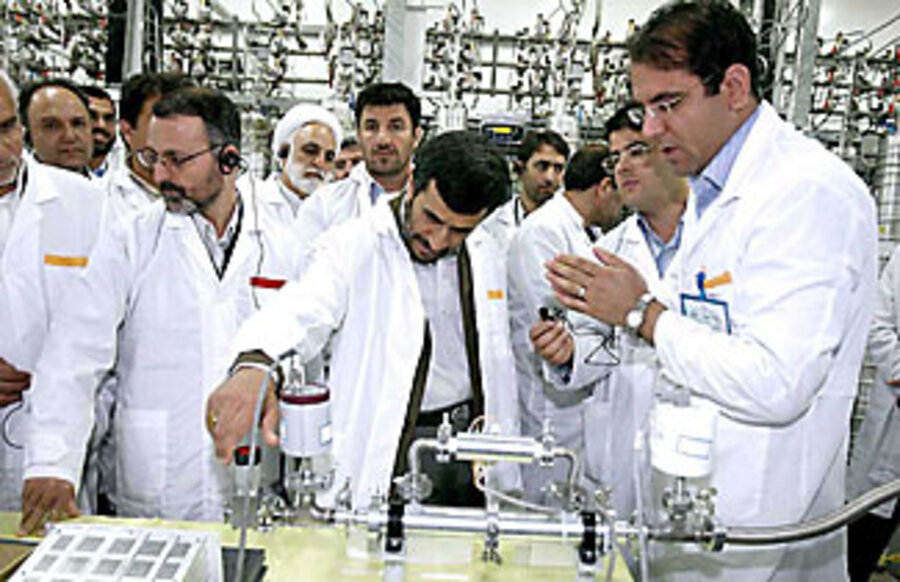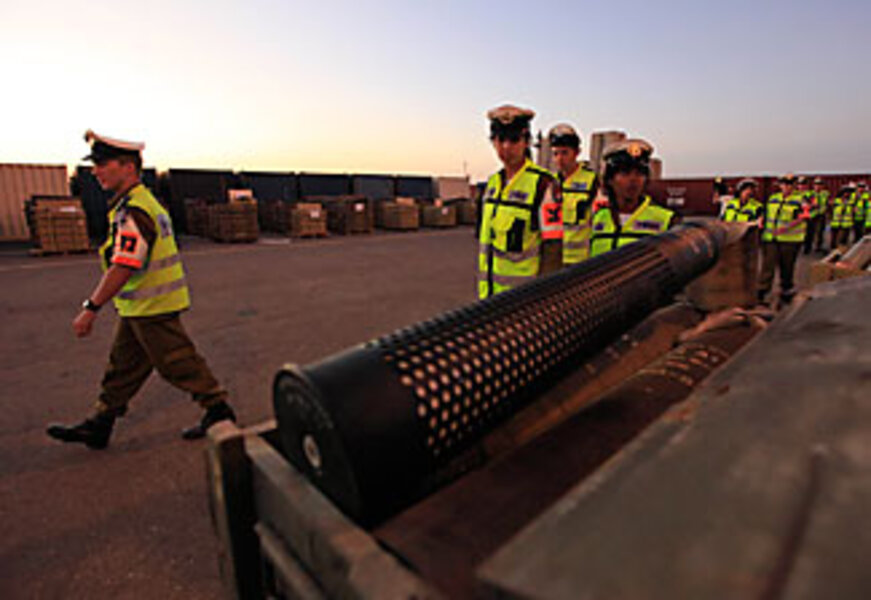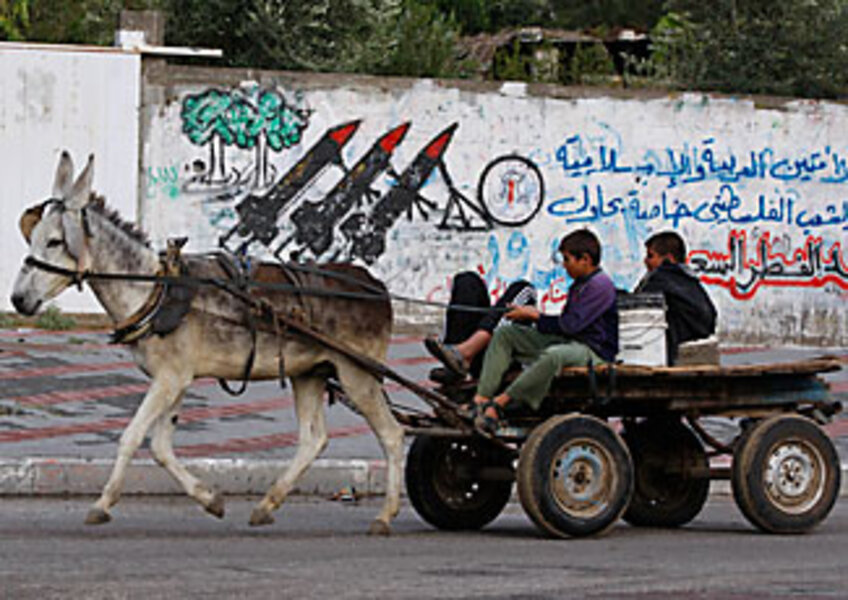The roots of Iran's nuclear program
Loading...
| washington
The head of the Orchid Office apparently thought he needed a little extra emphasis to make his point. The place was somewhere in Iran, shortly after Jan. 14, 2004. The occasion was a status report on activities of the Orchid Office – also known as "Project 111," Iran's effort to take a missile nose cone and outfit it with something that looks very much like a nuclear bomb.
The heart of the report was an update on such technical tasks as the development of a nose cone chamber of proper size. But the Orchid Office chief may have wanted to convey what he felt to be the historical importance of Iran's weapon activity. So he headed the first slide of his presentation with a motto, written in Farsi: "Fate changes no man unless he changes fate."
Fifty years after the shah first began to pursue nuclear energy technology, Iran's leaders may now be trying to change their nation's fate via acquisition of the most powerful weapons known to man.
Remember the "may." Tehran denies that it wants nuclear weapons, and says it is only interested in peaceful uses of nuclear energy.
The account of the Orchid Office report came from intelligence acquired by the United Nations International Atomic Energy Agency. That and other information in IAEA hands indicating weaponization activities is fake, says Iran. Iran's leaders may be split on the issue. It's possible – even probable – that they haven't yet decided whether to take the final step and actually produce a bomb.
But US officials are proceeding on the assumption that Iran wants nuclear weapons. They say that Tehran has hidden too much about its activities for them to think otherwise – and that today's Iranian leadership may see nukes as a prize capable of raising their nation to the world's top ranks.
There's a "widespread belief among experts that Iran's governing fractions perceive a nuclear weapons capability as a means of ending Iran's perceived historic vulnerability to invasion and domination by great powers, and as a symbol of Iran as a major nation," concludes Kenneth Katzman, a Middle East specialist at the Congressional Research Service, in a new report on Iran and US policy.
HOW DID IRAN REACH THIS POINT? The answer is more complicated than a quick glance at today's headlines might suggest. For one thing, Iran's nuclear efforts did not begin recently. They date back decades.
"Over the course of 50 years, perhaps the Iranian program could be described as 'fits and starts,' " says Sharon Squassoni, a senior associate in the nonproliferation program at the Carnegie Endowment for International Peace.
Ironically, the United States was Iran's first major supplier of nuclear technology. Washington signed a nuclear cooperation agreement with the shah – a staunch American ally – in 1957, under President Eisenhower's "Atoms for Peace" program. Construction of a US-supplied research reactor began in the Tehran suburbs in 1960 and went critical, with US-supplied highly enriched uranium as fuel, in 1967.
But the shah wanted more than a nuclear toy. He had grandiose plans for a network of 23 nuclear power reactors by the 1990s, with much of the equipment purchased from US suppliers. And as recently declassified documents make clear, the course of nuclear negotiations between the shah and an array of US officials was far from smooth.
US worries were like those of today: Officials thought it possible that Iran would build on nuclear power programs to develop weapons technology.
A secret 1974 Defense Department memo, declassified and posted online by the National Security Archive, noted that stability in Iran depended heavily on the shah's personality.
"An aggressive successor to the Shah might consider nuclear weapons the final item needed to establish Iran's complete military dominance of the region," noted the memo.
The shah became increasingly irritated as a series of US presidents objected to his desire to reprocess spent reactor fuel on Iranian soil. He viewed this as a national right granted him under the Non-Proliferation Treaty, which Iran had signed in 1968. "He had a nationalist perspective that had some parallels with [Iran's position] today," says Dr. William Burr, director of nuclear history documentation at the National Security Archive.
The two sides squabbled for years over how much control the US would retain over Iran's nuclear efforts. American officials didn't really think the shah wanted nuclear weapons, at least right away. But they worried he wanted to preserve that option. When US scientists toured the site of Iran's planned Esfehan Nuclear Technology Center, they noticed that it was unusually large. Seven miles east of a population center, located between two mountains, the site was geographically reminiscent of a US facility. "One member of the ... team commented on the similarity of this location to the US Sandia Weapons Laboratory location," noted a cable from the US Embassy back to Washington.
In the late 1970s, the two nations finally struck a deal. Iran would get nuclear technology, but the US would control when and where any reprocessing of fissile material would take place. And then came the revolution. Protests and pro-cleric guerrillas forced the shah from power in February 1979. The nuclear deal with the US died. For 10 years, Iran's nuclear program remained on hold, as Ayatollah Khomeini established a Shiite theocracy and then fought the bitter Iran-Iraq War.
YEARS LATER, THE NOTORIOUS nuclear technology smuggler A.Q. Khan boasted about how he and his contacts helped Iran's nuclear program revive. Mr. Khan is a Pakistani scientist who worked at European uranium enrichment facilities. By the late 1980s, he'd returned home and set himself up as a kind of Nuke-Mart – the closest thing to a one-stop shop for clandestine nuclear needs.
Around that time, Mr. Khan was approached by Iranian representatives interested in purchasing some nuclear items. He was happy to help.
"If Iran succeeds in acquiring nuclear technology, we will be a strong bloc in the region to counter international pressure," Khan told a Pakistani broadcast journalist in August, according to a transcript from the US director of national intelligence's Open Source Center. "Iran's nuclear capability will neutralize Israel's power."
Khan said he sent the Iranians to Muslim suppliers in Sri Lanka who did business out of Dubai. But many experts believe Khan himself provided Iran with uranium-enriching centrifuge technology. "Iran obtained its centrifuge designs and initial lot of material from A.Q. Khan," says Jacqueline Shire, a senior analyst at the Institute for Science and International Security.
Thus began the bob-and-weave period of Iranian nuclear development. While US pressure managed to stop some technology transfer – such as a deal with Russia for laser enrichment technology – Iran's illicit procurement network provided a stream of acquisitions. Typical were the efforts of Mohsen Vanaki, a German-Iranian trader recently found guilty by a German court of brokering the illegal sale of high-speed cameras and radiation detectors for the Iranian nuclear weapons program.
Mr. Vanaki dealt with a Tehran-based front company named Kimya Pakhsh Sharg, according to German court documents reviewed by the Institute for Science and International Security. Vanaki bought the devices from a Moscow-based manufacturer, Bifo Company, falsely naming a Middle East university as the end user. Vanaki was stopped after he was caught trying to buy Swiss-made night vision goggles. But his sentence, imposed in September, was relatively light: 22 months, suspended, and a Є5,000 fine. Prosecutors are appealing, asking that Vanaki spend three years in jail.
In the end, the case may show how hard it is to stop the flow of illicit technology. "A determined smuggler can often evade detection for years," concludes an ISIS report on the subject. "If caught, prosecution is difficult."
UNDER THE SHAH, Iran developed a base of nuclear facilities. After a fallow period of 10 years, Iran's current leadership has finished some of the projects started under his regime – notably the Bushehr light-water reactor – and developed its own extensive network of nuclear sites, via procurement both legal, and not.
That is where we are today. Iran has a large enrichment plant at Natanz, with perhaps 5,000 operable centrifuges, piling up about 2.75 kilograms of low-enriched uranium daily. It has another site for centrifuges, recently revealed, near Qom.
According to the IAEA, Iran now has a stockpile of about 1,600 kilograms of low-enriched fissile material. If they wanted, Iranian leaders could feed that stuff back through the centrifuges, and, in relatively short order, they would have enough highly enriched uranium to make a bomb.
What are Iran's intentions? Tehran's past deceptions, including withholding information from the IAEA, lead many in the West to conclude that Iran wants to at least develop the ability to produce weapons. But that is not the same as having a bomb. No matter how much fissile material a nation has, or how many Project 111-like studies it has run, the construction of nuclear weapons takes time.
"Building nuclear weapons is not like assembling furniture at IKEA," said Greg Thielmann, a senior analyst at the Arms Control Association, at an October seminar on Iran's capabilities. "It is both an art and a science. There is no evidence Iran has completed this work yet and little reason to believe it could do so quickly." •








